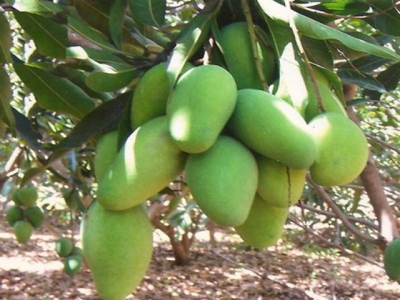How to Grow a Mango Plant Indoors

Wondering if you can grow a mango plant indoors? Yes, you can. It may never bear fruit, but it makes an attractive house plant and can be a fun project.
Mangoes are native to southern Asia, but were carried by monks and explorers to other subtropical regions throughout the world. Mangoes are prized for their fragrant aroma and sweet flavor. They are a versatile fruit, used in desserts, such as sorbets and smoothies, or in savory dishes, such as salsas and sauces. Mangoes are delicious fresh or dried.
In the tropics, this plant grows 30 to 100 feet high, making it a bit large for the home grower. But grown in a pot and occasionally pruned, a mango plant makes an attractive indoor houseplant with glossy leaves and a bushy, shrub-like appearance. Commercially grown mangoes typically produce fruit within six to seven years, although getting an indoor plant to produce fruit is difficult because of the lack of light. Mango plant flowers produce volatile substances which can cause allergic reactions or respiratory problems in some people.
To grow a mango at home, follow the steps below:
- Pick a ripe mango from the market. Seeds from fully ripe mangoes germinate more quickly than those from firm, under ripe fruits. A mango plant grown from seed may not resemble the parent plant or produce identical fruit. Buy a nursery propagated seedling if you prefer.
- After you’ve eaten the juicy fruit, scrape any remaining flesh off the mango with a scraper. Pry the outer shell open with a chisel and carefully remove the inner seed.
- Insert two small toothpicks 1/8-inch into each side of the mango seed and set the mango seed in a pint-size jar of water so that half the seed is submerged. Rest the toothpicks on the jar so the upper portion of the seed remains dry.
- Wait two weeks for the seed to germinate, adding more water when the water level falls below the seed.
- Once the seed sprouts, producing small white roots remove it from the water and plant it in a 10-gallon pot with good drainage. Fill the pot with a lightweight potting mix containing compost and place the seed 2 inches below the surface with the rooted portions pointing downward. Place the pot in a warm, sunny location of the house.
- Water the soil frequently to keep it evenly moist and spray the plant occasionally with a spray bottle filled with water to keep the evergreen leaves clean and increase humidity.
- Feed the mango plant monthly during the summer months with a balanced, water-soluble houseplant fertilizer, but withhold fertilizer during the winter and reduce water, as well.
- Pinch the top leaves off the mango plant occasionally to maintain its compact size and improve its appearance.
- Place the mango plant under grow lights during the winter to encourage fruiting.
Similar to growing an avocado tree from seed, growing a mango from seed is an unpredictable, but interesting, experiment. For best results, plant the mango in a large container and keep the soil moist. Try to simulate the plant’s native environment, which is warm and humid, and be patient. Mangoes take several years to develop and may never produce fruit.
Related news
 How to Grow and Use Mint
How to Grow and Use Mint Mint is a versatile plant that can be used in many food and drink recipes. There are many varieties of the hardy herb, which can be eaten or planted to provide
 Biodynamic preparations and compost
Biodynamic preparations and compost A distinguishing feature of biodynamic farming is the use of nine biodynamic preparations which are said to enhance soil quality and stimulate plant life.
 How to Grow Tomatoes from Cuttings
How to Grow Tomatoes from Cuttings Did you know that a new tomato plant can be grown from just a snip off of a mature tomato plant? The cells within the stems of tomato plants are capable